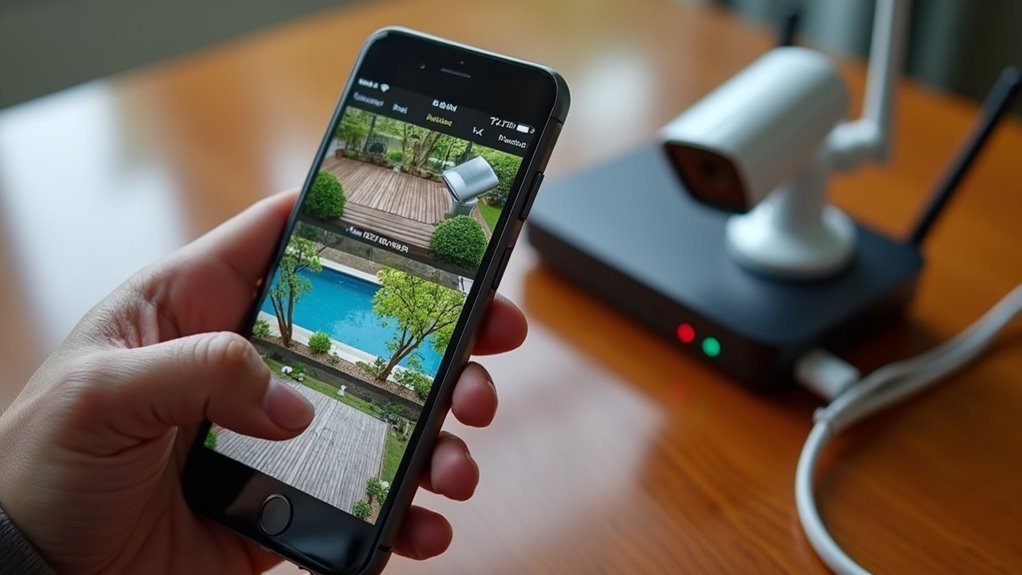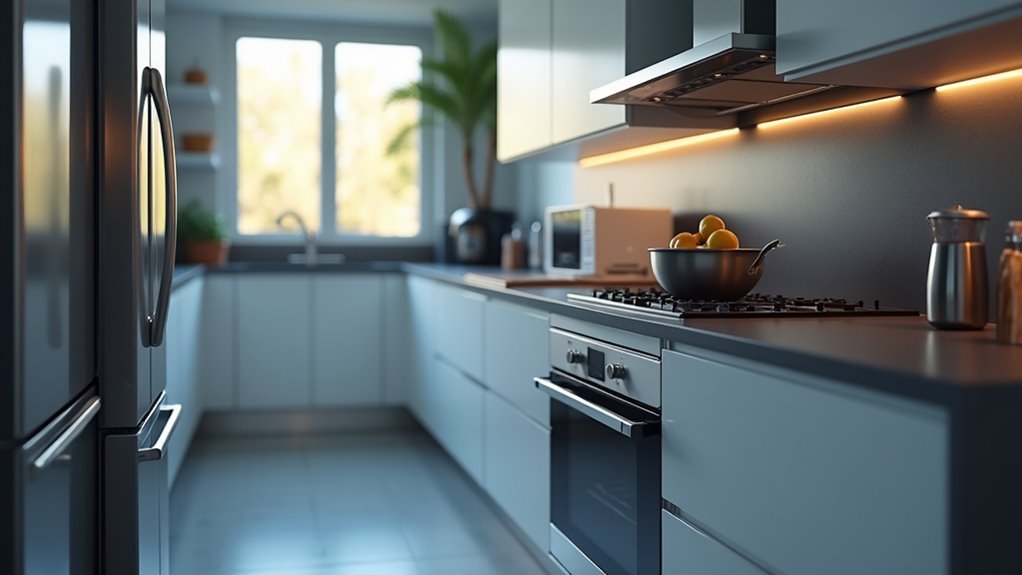You’ve probably noticed your Home Assistant getting sluggish as months pass, especially if you’re running multiple sensors and automations. The default SQLite database that ships with Home Assistant wasn’t designed to handle the massive data influx from modern smart homes, and it’s likely creating invisible bottlenecks that’ll only worsen over time. What starts as minor delays can escalate into system crashes, corrupted data, and frustrating performance issues that threaten your entire smart home setup.
Default SQLite Database Limitations

While Home Assistant ships with SQLite as its default database solution, this configuration presents several significant limitations that can impact your system’s reliability and performance.
Your SQLite database becomes vulnerable to corruption, especially when running on SD cards, potentially causing irreversible data loss. Over time, you’ll notice your default database grows excessively large, creating performance bottlenecks and slower data retrieval speeds.
The constant write operations will shorten your SD card’s lifespan, making SQLite unsuitable for long-term deployments.
You’ll face scalability challenges as your smart home expands, since the default database isn’t optimized for large datasets or high-frequency events. Additionally, SQLite’s limited concurrent write support creates performance issues when multiple devices interact simultaneously with your system.
Performance Issues With Large Data Sets
As your smart home ecosystem expands and generates increasing amounts of sensor data, you’ll encounter significant performance degradation when Home Assistant’s SQLite database grows beyond several gigabytes.
These performance issues manifest as slow read/write operations that create noticeable delays when accessing historical data, generating reports, or loading the interface.
Slow database operations create frustrating delays when viewing historical data, running reports, or navigating your Home Assistant interface.
You’ll experience increased latency during event processing, making your Home Assistant database less responsive to automation triggers and state changes.
The system becomes sluggish when querying historical sensor readings or displaying charts in the frontend.
Large datasets force SQLite to work harder, consuming more system resources and creating bottlenecks that affect your entire smart home’s responsiveness and user experience.
SD Card Corruption and Reliability Problems

Beyond performance degradation, Home Assistant’s default SQLite database faces even more serious threats when you’re running it on SD card storage.
SD card corruption represents one of the most devastating issues you’ll encounter, often resulting in complete data loss and system instability. The constant write operations from database transactions accelerate wear on your SD card, greatly shortening its lifespan.
When corruption strikes, you’ll typically need to delete and recreate the entire database, wiping out all your historical data unless you’ve maintained regular backups.
Database bloat compounds these problems, as SQLite files grow increasingly large and strain your SD card’s limited performance capabilities.
Shifting to SSDs or external databases eliminates these reliability concerns entirely.
Database Size Management Challenges
Even when your SD card remains stable, Home Assistant’s default SQLite database presents significant size management challenges that’ll quickly consume your available storage.
The recorder component saves raw data for 10 days by default, but without proper configuration, your database will grow exponentially as it captures every sensor reading, state change, and automation trigger.
You’ll find that entities like weather sensors, motion detectors, and temperature gauges generate thousands of data points daily.
This constant data accumulation creates a snowball effect where your database size management becomes increasingly difficult.
The default SQLite setup doesn’t automatically optimize storage, meaning you’re responsible for implementing retention policies, excluding unnecessary domains, and regularly purging old data to prevent your system from grinding to a halt.
Benefits of External Database Solutions

When you move from SQLite to an external database solution like MariaDB or InfluxDB, you’ll immediately notice dramatic improvements in performance and reliability.
External database solutions eliminate the corruption risks that plague SQLite, especially when running on unstable SD card storage.
You’ll gain access to advanced data management capabilities, allowing integration with powerful visualization tools like Grafana for extensive reporting and insights.
MariaDB and similar solutions offer superior write performance and customizable data retention strategies tailored to your specific needs.
These external database solutions reduce your Home Assistant’s processing burden while providing optimized long-term statistics storage.
You can implement sophisticated data retention policies that maintain system efficiency without sacrificing historical data access, ultimately creating a more robust and scalable smart home infrastructure.
Mariadb Vs SQLITE Comparison
While SQLite serves as Home Assistant’s default database solution, MariaDB delivers superior performance and reliability that becomes essential as your smart home ecosystem expands. You’ll notice significant improvements in handling larger datasets and high-frequency data entries when switching to MariaDB.
| Feature | SQLite | MariaDB |
|---|---|---|
| Concurrent Access | Single writer limitation | Multiple simultaneous users |
| Data Integrity | SD card corruption risks | Robust reliability features |
| Scalability | Limited optimization options | Advanced storage engines available |
MariaDB’s advanced querying capabilities eliminate the locking issues you might experience with SQLite under heavy loads. You’ll also benefit from better data management through partitioning techniques, preventing the excessive database growth that commonly affects SQLite installations. The flexibility of MariaDB’s specialized configurations makes it ideal for demanding smart home environments.
Statistics Storage and Data Retention
As your Home Assistant installation matures, you’ll need to balance extensive data collection with efficient storage management. Your system captures device snapshots every 5 minutes as short-term statistics, then aggregates these into hourly summaries for the statistics table. This approach preserves historical trends while minimizing storage requirements.
Here’s how to optimize your data retention strategy:
- Configure entity exclusions – Remove unnecessary domains and entities from recording to reduce database bloat.
- Adjust retention periods – Modify the default 10-day raw data retention based on your storage capacity and needs.
- Monitor database size – Regularly analyze recorded events to prevent performance issues and corruption.
Long-term statistics guarantee you’ll maintain valuable historical data without overwhelming your database, whether you’re using SQLite or MariaDB.
Entity Filtering and Recorder Configuration
Since Home Assistant tracks every state change across all entities across all your devices and sensors, you’ll quickly discover that not all entities deserve equal storage priority.
Entity filtering through smart recorder configuration lets you exclude unnecessary domains or specific entities that generate excessive data without providing meaningful insights.
You can optimize your database by configuring the Recorder to exclude high-frequency sensors like motion detectors or weather updates that change constantly.
Use glob patterns for flexible filtering based on naming conventions, and adjust the `purge_keep_days` setting from the default 10 days to match your needs.
Complement your recorder configuration with streamlined Logbook and History integration settings.
Regularly analyze your data through SQL queries to identify problematic entities generating unnecessary database bloat.
Long-term Data Analysis Requirements
Beyond filtering out unnecessary data, you’ll need to contemplate what information deserves long-term preservation for meaningful analysis. Your recorder saves aggregated statistics with short-term data captured every 5 minutes and long-term data summarized hourly, striking a balance between detail and storage efficiency.
When planning your long-term data analysis strategy, focus on these key areas:
- Energy consumption patterns – Track usage trends across seasons and identify optimization opportunities.
- System performance metrics – Monitor device reliability and maintenance schedules over extended periods.
- Environmental conditions – Analyze temperature, humidity, and air quality changes throughout the year.
Consider integrating external databases like InfluxDB with Grafana for advanced visualizations.
Regular database performance monitoring guarantees your long-term data analysis remains efficient as datasets grow larger.
System Resource Optimization
While preserving valuable data remains essential, optimizing your Home Assistant database configuration can dramatically reduce system resource consumption and improve overall performance.
You’ll achieve significant system resource optimization by switching from SQLite to using MariaDB or InfluxDB, which handle larger datasets more efficiently.
Increasing your commit interval reduces write frequency, minimizing storage load and extending device lifespan.
Implementing recorder filters prevents unnecessary data writes, conserving storage while improving database performance by eliminating clutter.
Regular maintenance through purging old data and optimizing table structures enhances query performance while reducing resource consumption.
These configurations guarantee your Home Assistant runs smoothly without overwhelming your hardware, creating a more responsive smart home experience.
Data Backup and Recovery Considerations
Your Home Assistant database contains valuable historical data that you can’t afford to lose, making regular backups crucial for protecting against corruption and hardware failures.
You’ll need to implement automated backup strategies that go beyond the basic Supervisor snapshots, including external storage options like Amazon S3 or network-attached storage.
When database corruption does occur, having a solid recovery plan guarantees you can quickly restore your system without losing months or years of sensor data and automation history.
Automated Backup Strategies
When data loss strikes your Home Assistant installation, having automated backup strategies in place becomes the difference between a minor inconvenience and a catastrophic loss of years’ worth of historical data.
You’ll want to implement multiple layers of protection for your Home Assistant database through strategic automation.
Here are three essential automated backup approaches:
- Schedule regular snapshots using the Supervisor’s built-in feature for consistent local backups.
- Configure off-site storage by automatically uploading backups to Amazon S3 for redundancy.
- Set up monitoring scripts on your Linux server to track backup success and alert you to failures.
You should combine both full and incremental automated backups to optimize storage while maintaining quick recovery capabilities.
This thorough approach guarantees your smart home data remains protected without requiring manual intervention.
Database Corruption Recovery
Despite implementing robust automated backup strategies, database corruption can still occur in your Home Assistant installation, particularly when using SQLite on SD card storage. When corruption strikes, you’ll need swift recovery methods to restore your system’s functionality and preserve historical data.
| Recovery Method | Data Preservation | Implementation Difficulty |
|---|---|---|
| Database Recreation | Complete Loss | Easy |
| Full Snapshot Restoration | Complete Recovery | Medium |
| Off-site Backup Recovery | Complete Recovery | Medium |
SQLite database corruption often manifests through performance degradation or system errors. You can identify these early warning signs through regular monitoring. If corruption occurs, avoid recreating the database unless absolutely necessary, as this destroys all historical data. Instead, restore from your most recent Full Snapshot or off-site backup to maintain data integrity and minimize downtime during database corruption recovery.
External Storage Options
While local backups provide essential protection, external storage options create multiple layers of data security that safeguard your Home Assistant configuration against catastrophic failures.
Since SQLite databases are particularly vulnerable to corruption on SD cards, you’ll want strong external backup strategies.
Consider these external storage options for maximum data protection:
- Amazon S3 backups – Provides off-site redundancy that protects against local disasters and enables quick restoration when your system fails completely.
- Local Linux server storage – Facilitates rapid recovery with minimal downtime, keeping your backups accessible within your network for immediate restoration needs.
- Automated backup monitoring – guarantees successful execution of backup processes and maintains data integrity through thorough health checks of your external storage systems.
Migration Planning and Best Practices
Before you shift from SQLite to MariaDB, you’ll need to create thorough backups of both your existing database and Home Assistant configuration files. Proper migration planning prevents historical data loss and guarantees smooth changes between database systems.
Configure your Recorder component to exclude unnecessary entities and domains, which directly improves database performance by reducing write frequency and storage requirements. Use filters in configuration.yaml to control what data gets recorded, storing only essential information for better long-term management.
Database performance improves dramatically when you filter out unnecessary entities, reducing storage bloat and write operations.
After migration, establish regular maintenance routines including performance monitoring and retention adjustments. Create a read-only user for secure remote access, enabling external analysis without compromising data integrity.
These practices maintain ideal database performance and reliability throughout your Home Assistant deployment.
Frequently Asked Questions
Does Home Assistant Need a Database?
Yes, you’ll need a database for Home Assistant to function properly. It stores all your device states, events, and historical data. Home Assistant uses SQLite by default, but you can upgrade to more robust options.
Why Use Influxdb With Home Assistant?
You’ll get advanced querying capabilities and powerful visualizations through Grafana integration. InfluxDB handles massive time-series data efficiently, reduces your main database load, and automatically manages storage with flexible retention policies.
How Long Does a Home Assistant Retain Data?
You’ll find Home Assistant keeps raw data for 10 days by default. However, you can extend this period using the `purge_keep_days` setting in your recorder configuration to retain data longer.
How Do I Clean up My Home Assistant Database?
You can clean up your Home Assistant database by configuring the recorder to exclude unnecessary entities, adjusting purge_keep_days settings, using SQL queries for deletions, and implementing glob patterns for filtering.





Leave a Reply